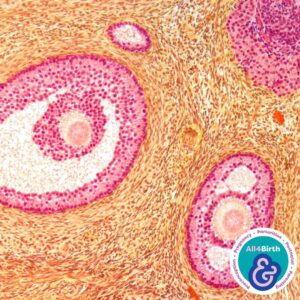Navigating the First Trimester: Understanding Physiological Changes and Signs of Pregnancy
Abbie Tomson
Midwife MSc, BSc, Yoga Teacher, Project Lead at All4Birth
@enevlorel
Embarking on the journey of pregnancy is an exhilarating and transformative experience for many women. The first trimester, weeks 1 to 12, is a crucial period marked by profound physiological changes as the body prepares to nurture and sustain a growing life. This freeflow article will delve into the intricate web of transformations during this time and explore the signs and symptoms that often accompany this miraculous process.
Navigating the First Trimester: Understanding Physiological Changes and Signs of Pregnancy
Hormonal Rollercoaster
- Human Chorionic Gonadotropin (hCG): This hormone is produced by the placenta shortly after implantation of the fertilised egg in the uterine lining. Its levels rise rapidly in the first trimester, peaking around 8-11 weeks of pregnancy and then gradually declining. hCG helps maintain the corpus luteum, which produces progesterone and oestrogen, crucial for sustaining the pregnancy until the placenta fully takes over hormone production.
- Progesterone: Progesterone plays a vital role in maintaining the uterine lining to support the implantation and growth of the embryo. During the first trimester, progesterone levels increase significantly, which helps regulate the immune response to prevent embryo rejection by the mother’s body.
- Oestrogen: Oestrogen levels also rise during the first trimester, primarily due to the production by the corpus luteum and later by the placenta. Oestrogen supports the growth and development of the fetus and the placenta. It also helps increase blood flow to the uterus and stimulates breast tissue growth in preparation for lactation.
- Relaxin: This hormone, produced by the corpus luteum and later by the placenta, helps relax the uterine muscles, pelvic ligaments, and other tissues in preparation for birth. It also plays a role in softening and widening the cervix.
Nausea and Vomiting
‘Morning sickness’, also known as nausea and vomiting of pregnancy (NVP), is a common symptom experienced by many pregnant women, especially during the first trimester. NVP affects approximately 70-80% of pregnant women to some degree. It typically begins around the 6th week of pregnancy, peaking around the 9th week, and tends to improve by the end of the first trimester. However, some women may experience it throughout their pregnancy.
Physiological Causes: Several factors contribute to the development of morning sickness:
- Hormonal Changes: The rapid increase in pregnancy hormones, particularly hCG and oestrogen, is thought to play a significant role. While the exact mechanism is not fully understood, these hormonal fluctuations can affect the gastrointestinal system and trigger nausea and vomiting.
- Increased Sensitivity: Pregnant women may become more sensitive to certain smells, tastes, and textures, which can trigger nausea and vomiting. This heightened sensitivity is believed to be linked to hormonal changes and may vary from woman to woman.
- Gastrointestinal Changes: Pregnancy can lead to changes in gastric motility, relaxation of the lower oesophagal sphincter, and increased stomach acid production, which can contribute to feelings of nausea and reflux.
- Stress and Fatigue: The physical and emotional stresses associated with pregnancy, along with fatigue, can exacerbate nausea and vomiting symptoms.
NVP tends to be most severe during the first trimester for several reasons:
- Organogenesis: The first trimester is a critical period for the embryo’s development, including forming major organs and systems. The hormonal changes and associated nausea and vomiting may serve a protective function by steering the mother away from potentially harmful substances that could affect fetal development.
- Placental Development: The placenta, which eventually takes over hormone production from the corpus luteum, begins to develop and mature during the first trimester. As hormone levels stabilise, symptoms of morning sickness often improve.
Breast Tenderness and Changes
During the first trimester, many women experience breast tenderness, soreness, and increased sensitivity. The breasts may feel fuller, heavier, and more tender to the touch. This tenderness is often one of the earliest signs of pregnancy, occurring as early as a few weeks after conception.
Physiological Reasons:
- Hormonal Changes: Oestrogen stimulates breast tissue growth, while progesterone helps maintain the uterine lining and prepare the breasts for lactation.
- Increased Blood Flow: Hormonal changes also lead to increased blood flow to the breasts, causing them to become more engorged and sensitive. This increased blood flow is necessary to supply nutrients and oxygen to the growing breast tissue and to support the development of milk-producing glands (alveoli) and ducts.
- Mammary Gland Growth: The breast tissue undergoes significant changes in preparation for breastfeeding. Mammary glands (lobules) and ducts proliferate and enlarge to accommodate milk production. These changes can cause the breasts to feel fuller and more tender.
- Ligament Stretching: As the breasts grow and become heavier, the ligaments supporting them may stretch, leading to discomfort and soreness.
- Areolar Changes: The areolas (the dark area around the nipples) often darken in colour and may become larger and more prominent. Montgomery’s tubercles and small bumps on the areolas may also become more noticeable. These changes are thought to aid in breastfeeding by making it easier for the baby to latch onto the nipple.
Fatigue: The Silent Challenge
- Hormonal Changes: Hormonal fluctuations, particularly increased progesterone levels, significantly induce fatigue during early pregnancy. Progesterone also has sedative effects, leading to feelings of drowsiness and fatigue. These effects can be particularly pronounced during the first trimester when progesterone levels are at their highest.
- Metabolic Demands: Early pregnancy is a period of intense metabolic activity as the body works to support the rapid growth and development of the embryo. This increased metabolic demand can lead to feelings of fatigue as the body redirects energy resources to support the needs of the developing fetus. The body may also experience fluctuations in blood sugar levels, especially in women who experience morning sickness and have difficulty eating balanced meals. Fluctuations in blood sugar can contribute to fatigue and low energy levels.
- Increased Blood Volume: During early pregnancy, the body produces more blood to support the needs of the developing fetus and placenta. This increase in blood volume can place additional strain on the circulatory system and lead to feelings of fatigue and exhaustion.
- Emotional and Psychological Factors: The emotional and psychological stress associated with pregnancy, such as anxiety about the pregnancy outcome, changes in lifestyle, and anticipation of parenthood, can also contribute to feelings of fatigue. Hormonal changes may also affect mood and emotional well-being, further exacerbating feelings of tiredness and lethargy.
- Sleep Disruptions: Many women experience disruptions in sleep patterns during the first trimester due to frequent urination, nausea, breast tenderness, and hormonal fluctuations. Poor sleep quality and disrupted sleep patterns can contribute to feelings of fatigue and daytime drowsiness.
Urinary Frequency: The Dance with Hormones
- Hormonal Changes: Increased hCG, oestrogen, and progesterone levels can increase blood flow to the pelvic region and stimulate the kidneys to produce more urine. Progesterone, in particular, has a muscle-relaxing effect on the smooth muscles of the body, including those of the urinary tract. This relaxation can lead to decreased bladder tone and reduced bladder capacity, resulting in the need to urinate more frequently.
- Uterine Enlargement: As the uterus begins to enlarge to accommodate the growing fetus, it puts pressure on the bladder, which lies just in front of it in the pelvic cavity. This pressure can compress the bladder and reduce its capacity, causing the sensation of needing to urinate more frequently, even when the bladder is not full. The uterus also expands upward into the abdominal cavity, displacing other organs, including the intestines and bladder. This displacement further reduces the bladder’s capacity and increases the frequency of urination.
- Increased Blood Volume: Early in pregnancy, the body produces more blood to support the needs of the developing fetus and placenta. This increased blood volume is filtered through the kidneys, increasing urine production. The kidneys filter waste products from the blood and regulate fluid balance. As blood volume increases, the kidneys produce more urine to eliminate waste products and maintain fluid balance, leading to increased urinary frequency.
- Changes in Fluid Balance: Hormonal changes, increased blood volume, and the body’s increased metabolic rate during pregnancy can affect fluid balance and hydration levels. Pregnant women may be more prone to retaining fluids, increasing the volume of urine produced and contributing to urinary frequency. Additionally, hormonal changes can affect how the body regulates electrolytes and fluid balance, influencing urinary frequency.
- Pressure on Pelvic Floor Muscles: The growing uterus and hormonal changes can also affect the pelvic floor muscles, which support the bladder and urethra. As these muscles stretch and weaken, they may be less effective at controlling urinary flow and maintaining bladder control, leading to urinary frequency and potential leakage.
Changes in Vaginal Discharge
- Increased Estrogen Production: A sharp rise in oestrogen levels stimulates the production of cervical mucus glands, leading to an increase in vaginal discharge. The increased oestrogen levels also cause the vaginal walls to become thicker and more vascular, leading to increased secretions.
- Increased Blood Flow to the Pelvic Region: Pregnancy increases blood flow to the pelvic area to support the growing uterus and fetus. This increased blood flow to the vaginal mucosa can stimulate the production of vaginal secretions. Additionally, increased blood flow to the vaginal walls may cause them to appear engorged and contribute to vaginal discharge.
- Cervical Changes: The cervix undergoes several changes during pregnancy to prepare for childbirth. As pregnancy progresses, the cervix softens, becomes more vascular, and produces more mucus. The increased production of cervical mucus helps form the mucous plug, which seals the cervical canal to protect the uterus from infection and prevent the entry of bacteria into the uterine cavity.
- Protection Against Infection: The increased vaginal discharge during pregnancy helps maintain vaginal pH balance and protects against infections. The acidic nature of the vaginal secretions creates an inhospitable environment for harmful bacteria and yeast, reducing the risk of vaginal infections. The mucus plug formed by the cervical secretions also acts as a barrier against pathogens, further protecting the developing fetus from infection.
- Physiological Changes in the Vagina: Pregnancy can lead to changes in the pH and bacterial flora of the vagina. The acidic pH of the vaginal secretions helps maintain the balance of beneficial bacteria, such as lactobacilli, which play a crucial role in preventing infections. These changes in vaginal flora and pH may contribute to alterations in vaginal discharge during pregnancy.
Conclusion
The first trimester of pregnancy is a time of awe-inspiring physiological changes, with each symptom and alteration serving a crucial purpose in nurturing the developing life. Understanding these transformations can empower expectant mothers to navigate this period and embrace the journey ahead confidently.
As always, pregnant women need to consult with healthcare professionals to ensure a healthy and well-monitored pregnancy.
Links to resources
 Books
Books
Brain Health from Birth: Nurturing Brain Development During Pregnancy and the First Year by Rebecca Fett
Real Food for Pregnancy by Lily Nichols
 Film Audio and Apps
Film Audio and Apps
Baby Buddy app, created by the Best Beginnings Charity
 Websites
Websites
References
- Lee, N. and Saha, S., 2011. Nausea and Vomiting of Pregnancy. Gastroenterology Clinics of North America, [online] 40(2), pp.309-334. Available at: <https://www.ncbi.nlm.nih.gov/pmc/articles/PMC3676933/>
- Coad, J. (2019). Anatomy and Physiology for Midwives. Elsevier.
- Marshall, J. E., & Raynor, M. D. (2020). Myles Textbook for Midwives. Elsevier.
- Tossetta G. (2023). Physiology and Pathophysiology of the Placenta. International journal of molecular sciences, 24(10), 9066. https://doi.org/10.3390/ijms24109066
- Pascual ZN, Langaker MD. Physiology, Pregnancy. [Updated 2023 May 16]. In: StatPearls [Internet]. Treasure Island (FL): StatPearls Publishing; 2024 Jan-. Available from: https://www.ncbi.nlm.nih.gov/books/NBK559304/















